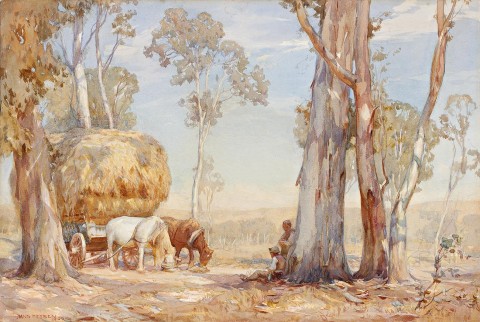THE MIDDAY REST, 1909
HANS HEYSEN
watercolour on paper
33.0 x 48.0 cm
signed and dated lower left: HANS HEYSEN / 1909
Private collection, Melbourne
Thence by descent
Private collection, Melbourne, acquired from the above in 1995
Hans Heysen enjoyed many triumphs in his lifetime, possibly none more than those of the years 1908 to 1912 when his art, especially his watercolours, achieved enthusiastic recognition. His first solo exhibition in Melbourne was opened by the Prime Minister, Alfred Deakin in 1908. Sales were spectacular, including the purchase of the oil painting, A Lord of the Bush, 1908, and the watercolour, Midsummer Morning, 1908, by the Felton Bequest for the National Gallery of Victoria. The following year Heysen was awarded the Wynne Prize for another watercolour, Summer, 1909, acquired by the Art Gallery of New South Wales. Our watercolour, The Midday Rest, 1909, is from the same time. The following year Heysen was awarded the Wynne Prize for another watercolour, Summer, 1909, acquired by the Art Gallery of New South Wales (then The National Art Gallery of New South Wales). Our watercolour, The Midday Rest, 1909, is from the same time. Two years later he won the Wynne Prize again with the oil painting Hauling Timber, 1911, likewise purchased by the Art Gallery of New South Wales. Lionel Lindsay praised Heysen’s watercolours as ‘Hymns to the Sun’ as his popularity continued to soar.1The Argus proclaimed Heysen’s 1912 exhibition at Athenaeum Hall to be: ‘undoubtedly the finest and most fascinating exhibition of watercolours ever seen in Melbourne’. Sales exceeded £1,500.2 Blamire Young, Lawrence Abrahams, John Connell and Dr Samuel Ewing were among the prominent buyers. Several purchased by the latter are now in the Ewing Collection of The University of Melbourne. In 1914, Connell gave the National Gallery of Victoria Silver and Grey, 1910, The Pomp of Parting Day, 1912 and A Summer’s Day, 1912. The critical praise for A Summer’s Day: ‘its vibration of the heat and light from midday sun beneath a brilliant and luminous cloud flecked sky’, might as easily have been applied to The Midday Rest.3
The financial rewards from these exhibitions and prizes enabled Heysen to make an important change in his life – to move to Hahndorf in the Adelaide Hills in 1908. A few years later he purchased ‘The Cedars’, the family home for the remainder of his long, creative life. The move was of particular importance to his art, enabling him to enrich it through a closer relationship with the landscape, and to know and be known by those who peopled it.
These characters – noble gums and local folk – appear and reappear in his art. The figure leaning against the gum in The Midday Rest is probably Alfred Collins, the easy-going old man and one of Heysen’s favourite models.4 This closer association did not go unnoticed. In Adelaide, The Advertiser observed that Heysen’s three watercolours in the Society of Arts annual exhibition of 1910, were readily identified with Mount Barker and Hahndorf. The Hay Waggon (sic), related to our watercolour in subject, was described as ‘probably secured while harvest operations were going on at the same “sleepy hollow”’.5 Enveloped in stillness, the narrative of The Midday Rest is the well-earned noonday break under the shade of majestic gums; the subject is the wonder of light. Heysen’s biographer, Colin Thiele observed: ‘Out of thousands of hours of intense observation that Hans had devoted to the gum, came pictures that lived and breathed its spirit’.6
1. Lindsay, L., ‘Hans Heysen: A Great Watercolour Painter’, The Bulletin, Sydney, 28 September 1911, The Red Page
2 ‘Mr Heysen’s Pictures’, The Argus, Melbourne, 9 July 1912, p. 9
3. ‘Exhibition of Pictures’, The Leader, Melbourne, 13 July 1912, p. 47
4. See Old Man Collins, 1912, charcoal drawing illustrated in Colin Thiele, Heysen of Hahndorf, David Heysen Productions, Adelaide, 2001, opposite p. 144
5. ‘Society of Arts’, The Advertiser, Adelaide, 14 April 1910, p. 10
6. Thiele, op. cit., p. 109
DAVID THOMAS
